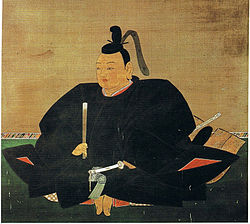Minamoto no Yoriie
Shōgun of Japan from 1202 to 1203 From Wikipedia, the free encyclopedia
Minamoto no Yoriie (Japanese: 源 頼家, September 11, 1182 – August 14, 1204) was the second shōgun (1202–1203) of Japan's Kamakura shogunate, and the first son of first shōgun Yoritomo.[1] His Dharma name was Hokke-in-dono Kingo Da'i Zengo (法華院殿金吾大禅閤).
Minamoto no Yoriie 源頼家 | |
|---|---|
 | |
| Shōgun | |
| In office 1202–1203 | |
| Monarch | Tsuchimikado |
| Preceded by | Minamoto no Yoritomo |
| Succeeded by | Minamoto no Sanetomo |
| Personal details | |
| Born | September 11, 1182 Kamakura, Kanagawa, Japan |
| Died | August 14, 1204 (aged 21) |
| Spouse | Wakasa no Tsubone |
| Children |
|
| Parents |
|
Life
Summarize
Perspective
Minamoto no Yoriie was born to Hōjō Masako at Hiki Yoshikazu's residence in Kamakura.[2] Before he was born, his father Yoritomo had Hōjō Tokimasa and his men carry stones to build the Dankazura on Wakamiya Ōji to pray for the child's safe delivery.[2] When Yoriie later himself had an heir, Ichiman, the child was also born at the Hiki mansion[3] to Hiki's daughter Wakasa no Tsubone, a fact which further consolidated an already strong emotional bond.[4] From this relationship Hiki gained considerable influence when Yoriie became shōgun, incurring the hostility of Hōjō Tokimasa, who was instead close to Yoriie's younger brother Senman (future third shōgun Sanetomo), and who was in his turn trying to leverage that relationship for political advantage. His childhood name was Manju (万寿).
When he was young, he was interested in military arts like fencing, and horse-riding. After his father's death in 1199, the 17-year-old became head of the Minamoto clan and was appointed sei-i taishōgun in 1202.[2] He was, however, criticized for his abandonment of his father's policies, and his mother forbade him from any political activity.[2] On June 30, 1203, his remaining powers were formally taken from him and assumed by a council of 13 elders, headed by his grandfather Hōjō Tokimasa.[2] He ordained as a Buddhist monk. Yoriie, in turn, plotted with the Hiki to subjugate the Hōjō clan. However, he failed, and was put under house arrest, where he was forced to abdicate. Then on July 17, 1204, he was assassinated in his mansion in Izu.[2] Yoriie was succeeded by his younger brother Sanetomo, the last of the Minamoto shogun to rule over Kamakura.
Hiki Yoshikazu's rebellion
Seriously ill, Yoriie proposed to name both his younger brother, Minamoto no Sanetomo, and his young son Minamoto no Ichiman to succeed him; the two would split power, governing separate parts of the country. It seemed natural to them that Hiki would then be the regent, even if unofficially, of young Ichiman. Hiki suggested to Yoriie that they arrange to have Sanetomo killed. Hōjō Masako, Yoriie's mother and wife of the first shōgun Yoritomo, allegedly overheard the conversation.
On a pretext, Hōjō Tokimasa invited Hiki Yoshikazu to his home and assassinated him. A battle between the clans ensued, the Hiki were defeated by a coalition of the Hōjō, Wada, Miura and Hatakeyama clans and were exterminated.
Yoriie died in Shuzenji, a small town in what was later called Izu Province, assassinated by his grandfather Hōjō Tokimasa.
The sons of Yoriie
Yoriie had two sons, Ichiman and Kugyō. Both of his sons would end up dead, like their father they would fall victim to the power struggle that followed Yoritomo's death. Ichiman (1198–1203) was the eldest. His mother, Wakasa no Tsubone, was Hiki Yoshikazu's daughter, and the child was brought up by the Hiki clan. It is said that he died in a fire that destroyed the Hiki residence.
Yoriie's second son Yoshinari, his only son to reach adulthood, was forced to become a Buddhist monk. In 1219, Yoshinari murdered his uncle Sanetomo on the stairs leading to the shrine of Tsurugaoka Hachimangū in the shogunal capital of Kamakura, an act for which he was himself slain on the same day.[5]
Family
- Father: Minamoto no Yoritomo
- Mother: Hōjō Masako
- Wife: Wakasa no Tsubone (d. 1203)
- Children:
Eras of Yoriie's bakufu
The years in which Yoriie was shōgun are all within only one era name or nengō: Kennin (1201–1204).
Notes
References
External links
Wikiwand - on
Seamless Wikipedia browsing. On steroids.
